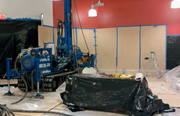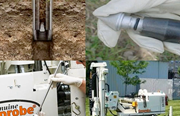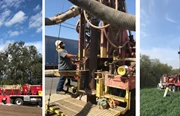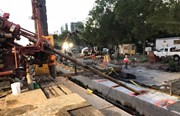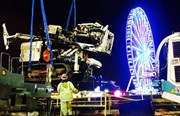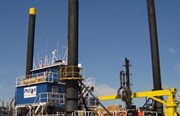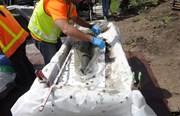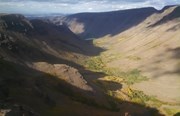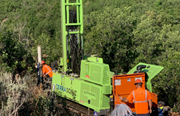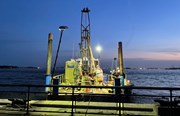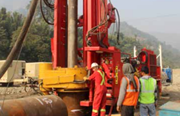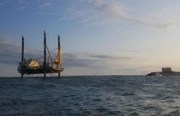5 Types of Projects Where You Should Consider Dual Rotary
By: Bill Poupis & Arnold LamonAs environmental professionals, we understand the importance of selecting the right drilling technology for each project. Choosing the wrong method can lead to delays, cost overruns, and even compromise project objectives. In this blog post, we'll discuss five project scenarios where dual rotary drilling can be an asset, helping you achieve your goals efficiently and effectively.
What is Dual Rotary?
When discussing dual rotary drilling, it is important to note that it isn’t just a drilling technology but an entire drilling rig with specialized technology. This method involves simultaneously advancing both the drill bit and the casing through the ground. This offers significant advantages, particularly when encountering challenging formations like boulders, cobbles, gravel, and sand. Casing the borehole as you drill enhances borehole stability and significantly reduces the risk of lost circulation.
Projects That Need Deep Drilling
Dual rotary technology can provide large diameter boreholes - up to 24 inches across. That makes it possible to drill deeper than a lot of other methodologies because the initial wide diameter provides room to telescope.
In one recent project, our crew began drilling an open hole using a reverse circulation methodology, but suddenly there were lost returns and the borehole was caving in. We switched to dual rotary and ran casing for 700 ft to get past the trouble zone. Once we reached a solid formation, we continued drilling with reverse circulation, and ultimately achieved a depth of 2200 ft below ground surface (bgs).
Projects Where You Don’t Want to Use Mud
When conducting environmental sampling, you don’t want to risk using any sort of circulation fluid in your borehole as it could potentially contaminate the sample you’re extracting. This becomes trickier the deeper below ground you go. With a dual rotary rig, though, you can go pretty deep using telescoping capabilities. Minimizing environmental impact by reducing the risk of borehole collapse and preventing contamination.
Projects Where You Suspect There May Be Loss of Circulation
Any time your project site involves gravel or basalt in the formation, there is the potential for lost circulation while drilling. Mud rotary or cased drilling could work in gravel formations, though dual rotary would provide the best of both as it cases and seals before letting you move forward with whatever drilling method you prefer. If you’re dealing with basalt, however, you won’t know how large the cavities encountered will be - which takes mud rotary off the table entirely. Drilling casing is really the only viable solution for basalt (i.e., fractured bedrock).
Projects Where You May Need Multiple Drilling Methodologies
Many environmental drilling projects encounter a range of soil and rock formations. While sonic drilling is often considered for complex sites, a dual rotary rig offers a versatile solution. Dual rotary rigs are capable of utilizing multiple drilling methods, including dual rotary, direct air rotary, reverse circulation, and mud rotary. This adaptability allows you to seamlessly adjust your approach as you encounter different formations, ensuring efficient and effective drilling operations.
For example, on a recent project in Utah, we encountered a challenging scenario while drilling a 2,000-foot water well. We started with a 9 7/8" pilot hole to 80 feet, followed by mud rotary drilling to 400 feet, where we set a 14" conductor. Continuing with mud rotary, we advanced to 950 feet when we encountered lost circulation. Recognizing the situation, we seamlessly transitioned to reverse circulation drilling, allowing us to complete the well to its target depth of 2,000 feet and set a 6" well. This successful outcome was achieved using a single dual rotary rig, demonstrating the versatility and adaptability of this technology.
Projects Where Time is Tight
While dual rotary may not be the fastest method for advancing casing in all scenarios, its efficiency in navigating challenging formations ultimately optimizes project timelines and budgets. By seamlessly drilling through difficult ground conditions, dual rotary minimizes delays and reduces the risk of unexpected setbacks that can derail project schedules and increase costs. Furthermore, by ensuring a stable and controlled drilling environment, dual rotary drilling minimizes the risk of accidents and incidents, enhancing project safety for your team. If you're facing tight deadlines and need to ensure a smooth and efficient drilling process, dual rotary drilling may be the ideal solution for your project.
Hopefully, you now have a sense of when you should consider using dual rotary for your future projects. You can also download our handy checklist for reference.
Want to learn more about the dual rotary technology? Access the on-demand webinar, Drilling 202: An Introduction to Dual Rotary Drilling. We cover the basics everyone should know about this drilling method and then answer questions during a Q&A at the end.
ABOUT THE AUTHORS

Bill Poupis
Sr. Vice President, Operations
[email protected]
Bill Poupis is the Senior Vice President of Operations for the California and Northeast regions. He is a geologist and drilling expert who has worked in the industry for over 40 years, and ensures his clients have the right people and technologies on every project. Bill oversees more than 200 employees across six locations, and leads them in performing safe and high quality work that hits project benchmarks and budgets.
Over the course of his career, Bill has provided drilling and related services for environmental, geotechnical, geothermal and oil and gas applications. He spent years perfecting technology for drilling and installing horizontal wells for oil production and, later, for environmental applications.
In his current role, Bill helps clients and junior environmental services professionals better understand drilling best practices, technologies, and applications. Bill’s ability to reimagine existing equipment for new purposes and work creatively on difficult projects makes him an ideal partner for clients facing challenging site conditions.

Arnold Lamon
Project Manager
[email protected]
Arnold Lamon is a Project Manager at Cascade Environmental. He joined the environmental services industry 25 years ago as a mechanic. Over the years, Arnold moved to a driller role and gained expertise in air rotary casing hammer (ARCH), reverse circulation, dual rotary and coring technologies. Thanks to his work in the environmental drilling industry and previous experience working with wastewater and electrical power (with degrees in both), Arnold’s clients trust him to anticipate, prevent and mitigate problems on the project site to keep things running smoothly and safely.





